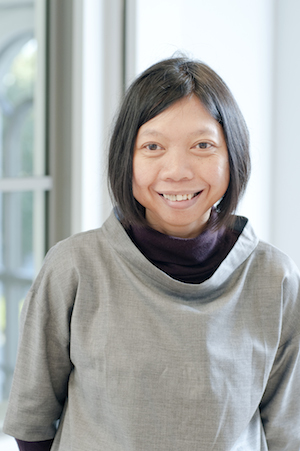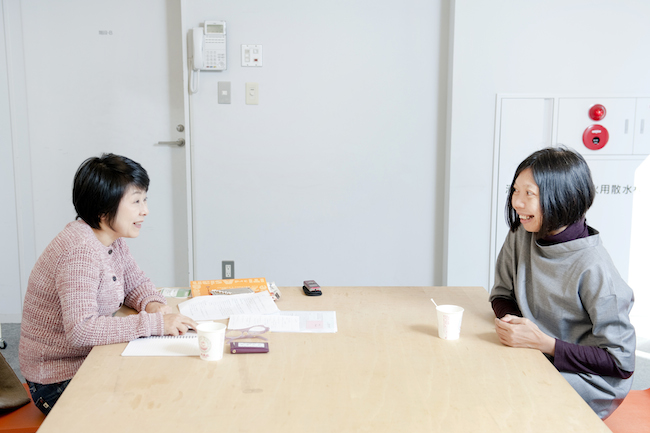Relationship between Tradition and Contemporaneity in Dance
Some days ago, at a dance performance, a Cambodian sitting next to me said to me, "I heard that tradition and contemporary dance are separated in Japan. That is a very interesting idea. We don't have that way of thinking." Sometimes I am also asked, "Is butoh one of the traditional dances?" On the other hand, in many Asian countries, contemporary dance is considered to be in continuation of traditional dance. What do you think of the relationship between tradition and contemporaneity?
Helly: Tradition is very strong, because of our diversity. I worked on this theme in my doctoral thesis: what "Indonesian" modern dance is since it has not really been discussed, partly because we tend to jump to the contemporary and that is when the confusion occurs. When did we - Indonesians - become modern? I would like to think about this question again, i.e., when Indonesian dance was becoming 'modern', when, quoting Afrizal Malna, the "I" enters the Indonesian dance? It is said that there is almost no 'ruptures' taking place between traditional dance and contemporary dance in Indonesia, but I cannot approve because I think 'ruptures' took place. For instance, the dance artist Sardono Kusumo, in the early stage of his career, (re)created a piece, titled Samgita Pancasona I-VIII, taken from an episode of Ramayana that was very different from traditional dance in its form. In Jakarta, the audience found it interesting and accepted it. However, two years later, in 1971, when it was shown in his hometown Solo, the audience got mad and threw rotten eggs to the stage. That was just one moment. There has not been discussion on the reason why that happened. I did ask, and one explanation is, "Well, there were purists who represent traditional ways of thinking, they were the ones who threw the egss to the stage." Nobody reconsiders the issue in terms of the body, i.e. what happened to it. My interest lies there. Tradition is always there, but there needs to be awareness of the necessity of exploring the primal physicality that has been lost through the usages of and the views on tradition as well as modernity. It's easy to say "tradition," but what is it? What is happening to the body? I am from Jakarta and I haven't been trained in any traditional dances but such short time in my childhood, so I had to collate information to respond to these questions. It took time for me to understand its complexity. For example, I understood something when I saw a ritual dance, Bedhaya Ketawang, that they say has been performed every year for the last 200 years in the main court of Surakarta, Central Java. It was one of the most beautiful dances I have ever seen. I understood that although they're performing but it's not to satisfy the audience. It's for something else, for a nobler idea. The old dance text says that they used to be performed by virgins aged 12 or 13 years old. But now it's different. Do you have to be virgin to perform the dance now? At least, it's obvious that they were no longer in adolescent years. The dancers were young, but they were likely in their 20s not younger. So I think we need to re-contextualize even ritual dances.

How do audience see traditional dance?
Helly: I think what they receive most comes from visual information such as the forms, techniques, costumes; or in forms of narratives such as Ramayana stories and local folklore performing arts languages. It is like they are following the traces of tradition, not the tradition itself. These things might be traces, but not the core of traditional dance. I have asked many people what the core is. The dancing bodies in Java and Minangkabau are very different. There is always what is called rasa, a word that is almost untranslatable. If someone from Jakarta imitates the techniques of Javanese dance, they say, "You might have mastered the technique, but the rasa isn't here. Your rasa is in Jakarta, and you are not Javanese." I then focused on looking at what choreographer Sardono did in the 1970s at the early stage of my study. Another important dancer, Ben Suharto, came after Sardono. He died young, so I didn't meet him, but his writing has remained and I need to read them. I have to be careful about saying this, but I think very few dancers I met in Indonesia have truly discovered tradition in their own body, so I think the current Indonesian dance is in a difficult situation in terms of understanding this complexity. Tradition is still mostly understood as something static, written on the stone; not something flowing, fluid or even something that is constructed by, say, the state. I am now interested in tracing the thoughts of old, traditional people and have been reading related books or talking to those whenever possible. Perhaps, some answers should be discovered there.
Future Activities
Lastly, I'd like to hear about your future plans.
Helly: Basically my work is project-based. After completing my term at Jakarta Arts Council in end 2015, I'd like to have more time to spare, since I haven't had enough time for studying and writing. All the writings, curations and producing work I have been involved in are connected to my ongoing study. I had organized a small international conference on Asian contemporary dance back in 2008, in Yogyakarta. It was a collaboration with a University of Sanata Dharma, a private universityand Kunci Cultural Studies Center, a group of young thinkers in Yogyakarta. I thought I needed a connection to a university to be able to organize the conference, so approached the private university that is said to be among the most progressive where I connected to an engaged professor, Dr St Sunardi. He was - still is - open-minded, and agreed that he would cooperate. Recently, I have involved him to my new project at the Council, to co-edit an anthology of Indonesian dance studies. The university is proposing for a new postgraduate study, and they offered me to join the teaching faculty. I don't want to be a full time academy, and I don't know when the program will materialize but I am looking forward to it. Apart from this teaching possibility, I really wish to continue curating, producing and writing as my core practice. Linking the teaching and the practice will be a great opportunity. Since late 2013, I have been producing for choreographer Fitri Setyaningsih. I got acquainted with her in 2005 and have seen her works for a long time, and in 2010 or 2011 she asked me to produce her work. In 2013, Indonesia Performing Arts Market (IPAM) was held, and Andrew Marshall from Australia, who was invited by the government to organize the market, was interested in presenting Fitri. I thought it was the time I start producing her then. Her works are not easy, and her creation processes take years. But our ways of working matched. So far, I enjoy working with her. Fitri creates her works mostly intuitively, never so intellectually. She is into reading nature vis-a-vis daily life. She has her own 'metaphysics'. She works slowly. She moves from project to project instinctively. My role is about placing her work in the Indonesian, or a broader, context. I interpret what is going on in Asia, and consider how and where she can be in the arena in terms of discourse.
I heard that you also work at the Asian Culture Complex in Gwangju, Korea that opens in September.
Helly: In the end of 2013, Kim Seong-Hee invited me alongside other curators for a meeting in Gwangju. I think she said that the project she was thinking of was too big to work on alone. After that, she conducted her own research in various regions, including Indonesian which I accompanied. When I met her again at tTPAM2014, she proposed "Orientalism" as the theme and asked me whether I want to respond to it. I think she created an entrance to discuss an important question about the practice in Asian contemporaneity. Since then, I have slowly been thinking about it on top of doing my other works at the Council etc. We have exchanged some emails here and there with her team. I work very slowly, so I found this interestingly organic.
When will the project be carried out?
Helly: First weekend of October 2015. I returned to writing and reflect on what it is to be Oriental, when did Orientalism as a practice and discourse emerge in performing arts, especially dance, and what is it? I think this leads to "gaze." Like the early modernists, it started with gaze. I thought about something like the contact point of Orientalism and modernism. I do think that is like two sides of the same coin.
Thank you for the interesting conversation. I look forward to your next project.

[February 15, 2015, at Yokohama Creativecity Center]
Program Director at The Saison Foundation. After coordinating the theatre and dance programs for a multi-purpose space "Studio 200," she joined The Saison Foundation in 1992. In the present post since 1996, she plans and manages the Foundation's grant programs for contemporary theatre and dance as well as its sponsorship programs. Her friendship with Helly Minarti has grown since the Asian Dance Conference in 2007.






